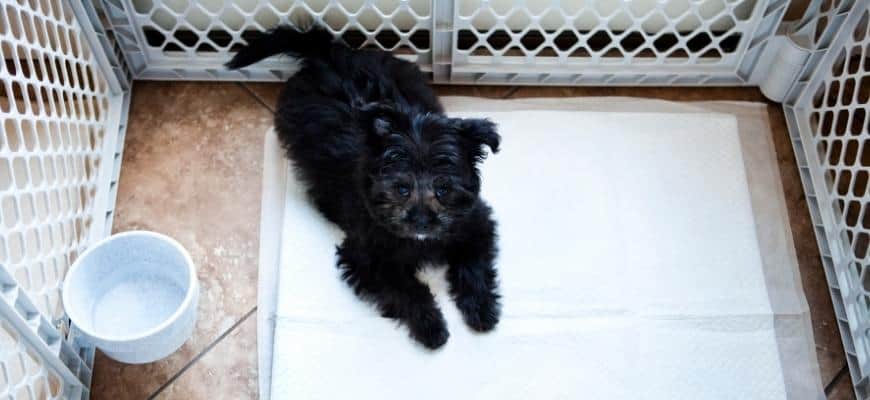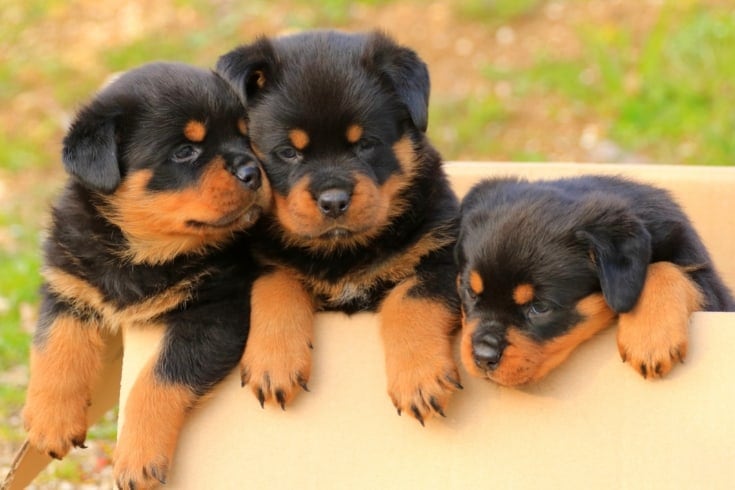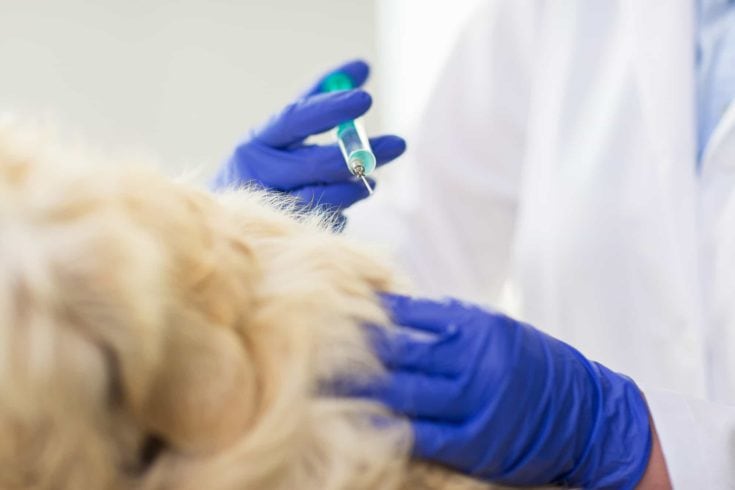Potty training your puppy is a priority for most pet parents. But when can puppies go outside to potty?
Can you take your puppy outside to relieve himself before his course of vaccinations is complete? Can your puppy go outside to pee if you carry him?
Read this guide to find out!
When Can Puppies Go Outside to Potty for the First Time?

As a new pet owner, you’ll want to know when you can take your puppy outside to go potty.
You can take your puppy outside into your backyard to potty train from eight weeks old. However, you must not take your puppy for walks in public places where other dogs are before your puppy has received his full course of vaccinations.
Vaccinations help to build your puppy’s immunity, but they aren’t fully effective until the course is complete.
Keep Potty Trips Short
Puppies have tiny bladders, so they need to go outside pretty frequently to relieve themselves. That can be a problem since your puppy’s immune system is susceptible to several nasty canine diseases that he could contract outside.
For that reason, you must keep potty trips outside as short as possible. Go directly to your puppy’s potty spot, allow your pet to pee, and then carry him right back inside to safety.
When Can I Put My Puppy on the Ground?

You can keep your puppy safe from diseases by avoiding putting him on the ground until his vaccination schedule is complete. That’s generally at around 16 weeks of age.
Be especially careful if you’re a pet owner with a multi-pet household or if wild animals have access to your backyard, as they could appear healthy while carrying diseases that could affect your vulnerable puppy.
If you have a private yard or garden, you have no other pets, and you can be certain that stray or wild animals can’t visit the area, you can take him outside for potty training purposes.
Carry your puppy directly to his designated potty spot and set him down so that he can do his business. Use your chosen cue words to encourage your puppy to go potty, and be sure to praise and reward him when he goes.
Once the deed is done, pick your puppy up again, and take him back indoors.
Veterinary Visits?
Some pet owners are reluctant to put their puppies on the floor when visiting the vet clinic.
However, we don’t consider the risk of your puppy contracting a disease from your veterinary center. Most vet clinic floors are thoroughly disinfected on a daily basis, so our advice to puppy parents is not to worry. In fact, allowing your puppy to sniff and explore the vet clinic is a relatively safe way for your furbaby to explore a new environment.
That said, if you’re still unsure, check with your vet.
What if I Live in an Apartment?

If you live in an apartment, it’s not a good idea to take a young puppy outside to a shared outdoor space for potty breaks. Shared areas are most likely used by other dogs, and your puppy could be exposed to bacteria and viruses that could be dangerous for your pup.
For example, Parvovirus in puppies can be fatal. For that reason, most vets recommend that you keep away from shared outdoor areas to protect your puppy from infection and disease risk until the little one is fully vaccinated at around 16 weeks of age.
The majority of puppy owners who live in apartments start potty training their puppies indoors by using a crate and puppy training pads. Once the puppy is fully vaccinated, it’s relatively quick and easy to retrain the pup to go outside when he needs to relieve himself.
When Is the Earliest You Can Take a Puppy Outside?
Although there will be some degree of risk and exposure to diseases, you can begin taking your puppy outside once he’s had his initial vaccinations at eight weeks old. Those shots will provide your puppy with some protection, and often a puppy will retain some of his mother’s antibodies as protection.
That said, it’s thought that puppies do not have full protection against diseases until 21 days following their second booster vaccination. So, ideally, you should wait until then to take your puppy outside.
Breeds at Risk

According to research, some breeds are more at risk of contracting diseases such as Parvovirus than others. For example, Doberman Pinschers, English Springer Spaniels, and Rottweilers are thought to be more at risk from Parvo until they have received their final vaccination.
When Do Puppies Get Vaccinated?
Puppies receive their first set of vaccinations at the age of eight weeks. Up until that age, your puppy will retain some of his mother’s protective antibodies. Those antibodies provide some protection for your puppy and immunity, but that protection wears off once the pup is weaned at around six weeks.
For that reason, vaccinations do not commence until the puppy is eight weeks old. Before that age, the puppy’s natural antibodies can interfere with the vaccine.
How Many Vaccinations Do Puppies Need?
Your puppy should receive his 12-week vaccinations four weeks following his first set of shots. The final set of vaccinations is given after a further four weeks.
That means your puppy is fully protected after 16 to 17 weeks of age, having received three sets of vaccinations in total.
What Vaccines Do Puppies Need?

The vaccinations that your puppy receives protect your pet against several nasty diseases that commonly attack canines.
The vaccines your puppy receives will depend on where you live, and your vet will guide you on what protection your puppy needs. Generally, puppies are vaccinated against potentially fatal diseases such as:
- Rabies
- Distemper
- Parvovirus
- Leptospirosis
Note that some boarding facilities insist that dogs are protected against kennel cough before accepting them as boarders.
FAQs
In this part of our guide, we answer a couple of commonly asked questions by puppy owners.
Q: Is it okay to carry a puppy outside to go potty?
A: Until your puppy is fully vaccinated, we recommend that you pick up your pup and carry him directly to his allotted potty spot in your backyard.
If you have to use a shared area with other dog owners and their pets, the risk of disease from an infected animal is higher than if you have a private garden. For that reason, it’s better to start potty training your pet indoors, using puppy pads.
Q: Can I take my puppy outside to pee before vaccinations?
A: Young puppies are vulnerable to several serious diseases that could make your puppy sick. If you allow your puppy to sniff around and play in your garden where stray animals and other pets have been, your furbaby could contract a disease. So, until your pup has received his full course of vaccinations and his final shots at 16 to 17 weeks, don’t set him down on the ground outside.
That said, you can introduce your puppy to a potty spot in a private garden that’s not shared by other pets or critters. So, we recommend that you keep potty trips as short as possible until your pup has received his full course of vaccinations.
Don’t allow your puppy to sniff around or play. Take your pet to his potty spot, encourage him to do his business, and then carry him straight back indoors.
Final Thoughts
Did you enjoy our guide to when puppies can go outside to pee? If you found the information included in this article helpful, please share it!
Generally, puppies can be carried outside and set down at their chosen potty spot when they are eight weeks old. However, that only applies if you live in a home with a garden or backyard and you have only one dog.
If you have to take your puppy to a public area, you must wait until your puppy is 16 weeks old and has completed his course of vaccinations. Otherwise, you risk exposing your pup to several serious canine diseases.
Did you potty train your puppy? How long did that take? Tell us about your furry friend in the comments box below!
